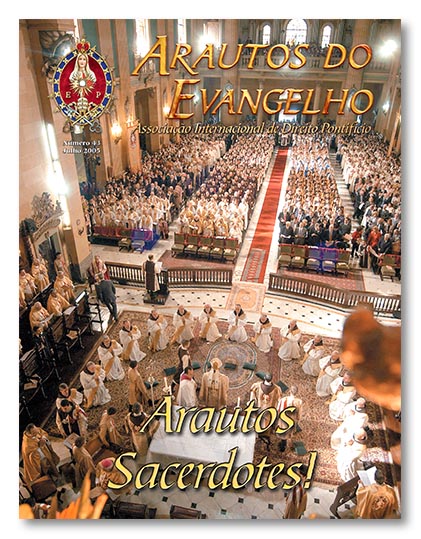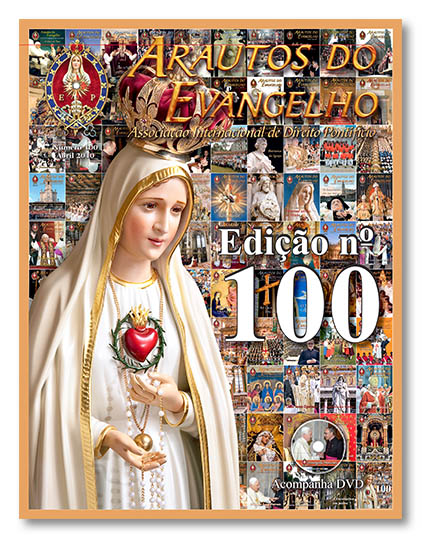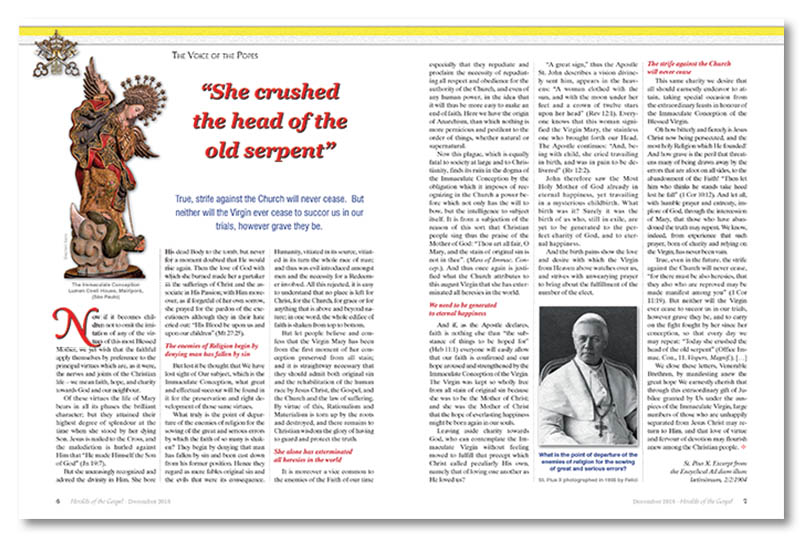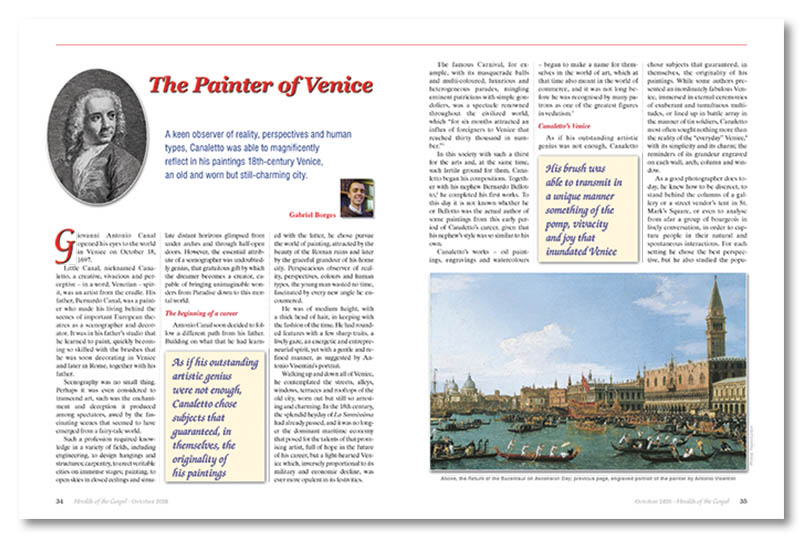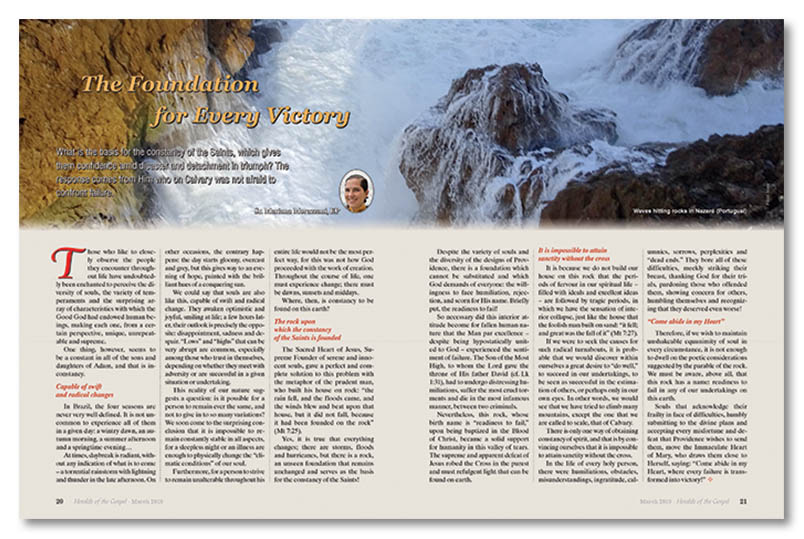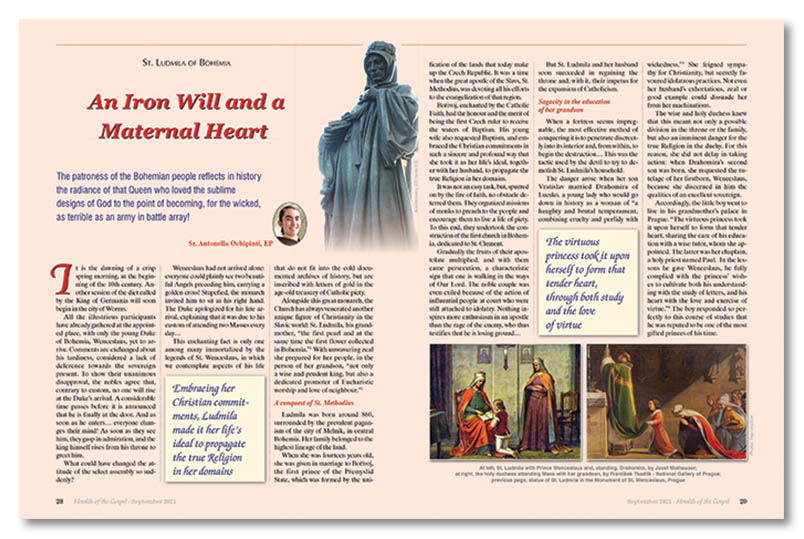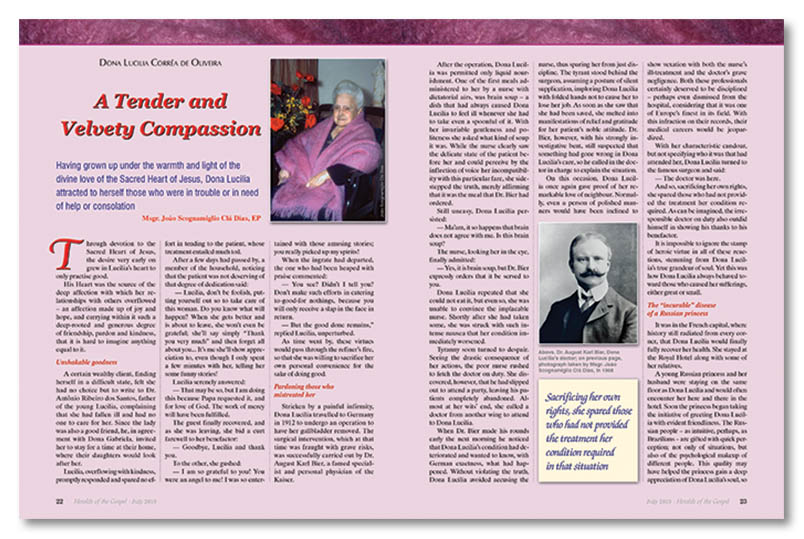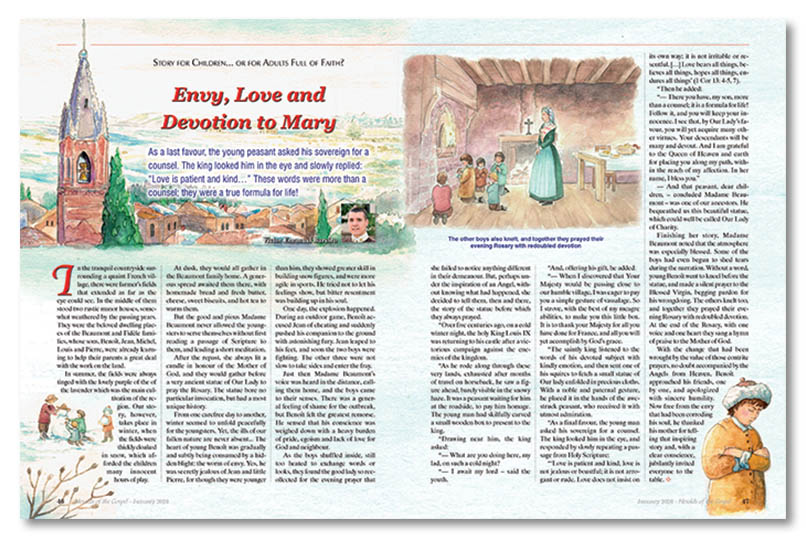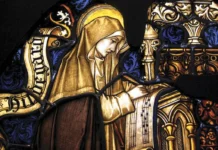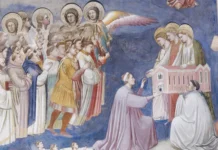On completing a meaningful anniversary, “Heralds of the Gospel” magazine offers a retrospective of its journey from its foundation to the present day, casting a glance of hope towards the future.
Through the Word, God created the world in a succession of days and works: let there be light, let there be firmament, let there be man… (cf. Jn 1:1; Gn 1). From its origin, humanity was endowed by the Lord with the gift of the word, through which the sons of Adam interact with one another and with their Maker.
Over the course of time, people developed new forms of communication, particularly writing, as a vehicle for transmitting their ideas. By this means God imprinted His own Word in the Old and New Testaments.
Other forms of literature – stories, poems or legends – were also used to speak about the Almighty. Among these, the genuinely Christian ones stand out, because they emanate from the side of Jesus and from the unshakable rock of Peter. It is in this context that the Catholic press is situated, with an ever more necessary role in a world so silent regarding God.
Under the impetus of the keys of Peter
At the dawn of the third millennium, more precisely on February 22, 2001, His Holiness John Paul II granted pontifical approval to the Heralds of the Gospel. Under the auspices of the keys of Peter, the fruits of the Paraclete were not slow to germinate. From the initial flame, new members and new houses were formed, spreading like wildfire throughout the four corners of the earth. Formation improved, the charism was consolidated and spirituality strengthened. But something was still missing…
At the origin of this work, a phenomenon similar to what happened at the beginning of Christianity could be observed. St. Paul, wherever he went – Rome, Corinth, Colossae, etc. – formed communities of the faithful; nevertheless, although he had been endowed with numerous gifts, Providence had not granted him a sort of “multi-location”… In fact, the Apostle of the Gentiles could not physically be in all those cities at the same time, in order to support the new converts. What was the solution? He sent letters to the different communities in order to instruct, encourage and confirm his disciples in the faith. If they were not able to enjoy his presence, at least they could feel the graces emanating from his written words. In that period of history, so to speak, the first Catholic “magazines” appeared.
Similarly, the avalanche of activities of the Heralds prevented them from being permanently in so many places. The spiritual assistant of the association, at the time also an official of the Vatican Secretariat of State, then threw down the gauntlet: the Heralds had to have a magazine, to be in contact with their adherents!

The founder, Msgr. João Scognamiglio Clá Dias, at that time still a layman, immediately presented the suggestion to the plenary assembly of the entity, and it was well received. The graces were tangible: it was certainly a sign from God. And if the gestation of the periodical had its difficulties owing to its being an unprecedented experience, time has shown that the magazine, published without interruption since its inception, would be a very efficient means for the new evangelization, so necessary in our days.
A development favoured by the blessing of the Holy Church
The first issue of the monthly magazine, published in January 2002, comprised only 28 pages, but the editorial already outlined the key to its vocation: the magazine aimed to be a “star of Bethlehem” for the people of our time, covering the most varied topics in the light of the charism of the Heralds of the Gospel. It also aspired “to increase among Christians devotion to the Eucharist, to Mary Most Holy and to the Chair of Peter, the three pillars of the spirituality of this private association of the faithful.”1
With the grace of God, the magazine, originally in Portuguese, grew in step with the fruitful apostolate of the Heralds. In conformity with Christ’s command to preach the Gospel to all nations (cf. Mt 24:14), Spanish, Italian and English versions were soon produced, with authors from the most varied backgrounds, reaching hundreds of thousands of homes throughout the world.
The pontificate of Benedict XVI provided fertile ground for further development of the publication, in large part due to the blessings that came from the definitive approval of the Heralds of the Gospel, as well as that of the Clerical Society of Apostolic Life Virgo Flos Carmeli and the Feminine Society of Apostolic Life Regina Virginum.
The word of God grew and spread (cf. Acts 12:24). The magazine improved its graphic design, means of diffusion and its articles, always seeking to preserve an elevated level of language while remaining accessible to its very diverse readership.
Due to the vertiginous increase in the use of the internet in the last decade, magazines in general have had to reinvent themselves. Several traditional press outlets have suffered a sharp decline in circulation and subscriptions. With a slight delay, the Catholic printed periodicals have also suffered the impact of the new technologies. Many of them gave up along the way and closed down their activities.
However, for Msgr. João’s spiritual children, retreat is not a valid option. In this new global context, Heralds of the Gospel magazine has certainly had to adapt. With the speed of information in the digital world and the ease of access to daily news, it has begun to focus less on themes of ecclesial daily life, out of the conviction that nothing is more current than the Gospel, of which the monthly publication is the herald. Moreover, the Good News always retains its springtime freshness, since it comes from God, who is the same yesterday, today and for ever (cf. Heb 13:8).

At the same time, the public has shown a lively interest in the writings of Dr. Plinio Corrêa de Oliveira, inspirer and master of the Heralds’ founder. This distinguished Catholic thinker was active in the press from a very young age, as director, for example, of the newspaper O Legionário, the official organ of the Archdiocese of São Paulo, today O São Paulo. Later, he became one of the longest-serving columnists for the Folha de São Paulo, the most widely circulated newspaper in Brazil, with which he collaborated for more than two decades. Not to mention his published works, many of them best-sellers. For these and other reasons, it can be affirmed that the art of writing – with the point of the sword, when necessary – is at the very root of the Heralds’ mission, engraving its mark not only on paper, but also in the history of the institution.
In recent years, graces obtained through the intercession of Dona Lucilia, Dr. Plinio’s mother, have also increased, by Heaven’s blessings. The sensus fidelium noted a life of exemplary fulfilment of the Decalogue, confirmed by several favours, many of them of a truly miraculous character, obtained by invoking her. The reputation for holiness of this Catholic São Paulo lady was increasingly consolidated – an essential condition, according to the tradition of the Church, for her elevation to the altars. Attentive to the spiritual instinct of the faithful, particularly of its subscribers, the magazine started to print extracts from the biography of Dona Lucilia, as well as reports of supernatural events connected to her person.
The excellent reception of these last two initiatives surprised even the organizers of the magazine.
A young dynamic team, eager to evangelize
In general, the structure of a prestigious periodical is based on the hiring of hundreds of employees, both in the editorial and administrative areas. This magazine was formed, a contrario sensu, in a very organic manner: all it took was the constitution of an editorial board that encouraged the Heralds to write, and soon the number of articles multiplied. And that is essentially how it remains today.
In fact, with rare exceptions, the articles are written by the members themselves, especially the more dynamic laity who, with the “liberty of the children of God” (Rom 8:21), find in the publication a channel to express themselves through articles of the most varied content, at times inspired by the perennial deposit of the Faith, at times conditioned by the circumstances of the moment.
The fame and credibility of a vehicle of information is largely assured by the years of experience of its authors. However, the magazine also makes room for young writers, for the little ones, in the conviction that although they may lack experience, they abound in perfect praise (cf. Mt 21:16).
Particularly symptomatic of this is the fact that some of the young writers were born after the magazine’s founding. This circumstance, rather than revealing a weakness, constitutes one of the publication’s strongest underpinnings, since it demonstrates the existence of a consolidated school of thought with continuity in the emerging generations, a factor without which any intellectual work is doomed to failure.
At the service of truth, through beauty
As has already been mentioned, the magazine covers a wide variety of topics, always with the characteristic note that distinguishes the apostolate of the Heralds of the Gospel: beauty. Indeed, the association has the full conviction that truth and goodness can only be well received and understood if they are surrounded by the splendour of beauty.
Accordingly, the magazine covers are characterized by beautiful images, bequeathed by the centuries-old tradition of the Church or by the association’s activities throughout the world. The editorials, in turn, are intended to be a kind of display case of the magazine. Much commented on by its readers, especially of late, they seek to offer a renewed message to address the perplexities of today’s Catholics.
The texts published in the section The Voice of the Popes bear witness to the immense treasure of the Papal Magisterium, in harmony with the theme of the issue. The periodical also always includes a hagiography because, as the old saying goes, “words convince, but example moves.” There is no nobler mission for a Catholic magazine than to sanctify its readers.
The Heralds Worldwide section is a sort of calling card, or small sample of the apostolate undertaken by the association in the countries where it is active. The pages of Story for Children… or for Adults Full of Faith? vividly present one of the most effective methods for intellectual and human formation: the narration of stories, always enveloped in innocence, simplicity and piety. The final pages, fully illustrated, feature an article that seeks God through the via pulchritudinis, that is, the way of beauty.
Finally, since its inauguration, the magazine also enjoys an incomparable privilege: the Gospel commentaries published uninterruptedly by the founder of the Heralds. One of the secrets of his excellent and cogent composition is that he writes not behind a desk, but before the Blessed Sacrament exposed. His reflection is also based on lively preaching, in the manner of the Fathers of the Church, who harmonized the intellectual life with the pastoral.
In fact, one of the most notable gifts of Msgr. João is that of harmony. In the likeness of the first Christian community, he succeeded in forming among the members of the Heralds of the Gospel “one heart and soul” (Acts 4:32). And the magazine, the association’s doctrinal framework, was naturally imbued with this esprit de corps.
It is well known that writing style is one of the most distinctive characteristics of any author. Among the Herald writers, however, we can find a common denominator, namely, the burning desire to touch the deepest chords of the reader’s soul, according to the famous French saying: “Intelligence can only speak; it is love that sings.”2 In this sense, the magazine forms a kind of “polyphonic choir”, composed of different but always harmonious voices.
Founded on the immutable doctrine of the Church
St. Paul teaches that “the Lord is the Spirit, and where the Spirit of the Lord is, there is freedom” (2 Cor 3:17). In fact, the Paraclete speaks when and with whom He wishes. But how can we discern whether a certain doctrine comes from above? First of all, by examining its consonance with the truth, since the Holy Spirit is essentially the “Spirit of Truth” (Jn 16:13). Thus, the editorial staff of Heralds of the Gospel magazine distances itself from ideologies contrary to Him who defined Himself as the Truth (cf. Jn 14:6). Truth has every right to manifest itself; lies have no prerogative whatsoever.
Finally, a question arises: why were there great Catholic writers in the past who influenced – even through the traditional press – countless souls, and why is it so difficult to find them today?
For a very simple reason: they are no longer Catholic. In fact, part of the editorial crisis that has plagued publications claiming to be Catholic in recent years has its roots precisely in their lack of Catholic identity. The pages of these periodicals, not uncommonly betray an unprecedented affinity with the tabloid media, promoting gratuitous attacks on the Church, its entities and its members. The Lusitanian poet rightly sang: “There is no enemy so vicious as the false virtue of the sincere!”3 For the sake of peace, we will refrain from entering into details, for the Heralds themselves were victims of such perverse attitudes. However, if necessary, the topic may be taken up again in the future…
In any case, Pope Leo XIII urged: “Seeing that the principal instrument employed by our enemies is the press, which in great part receives its inspiration and support from them, it is important that Catholics oppose the evil press by means of a press which is good, for defence of the truth, born of love of religion, and for upholding the rights of the Church. While the Catholic press is occupied in laying bare the perfidious designs of the sects, in aiding and defending the actions of the sacred pastors, and in defending and promoting Catholic works, it is the duty of the faithful to efficaciously support this press, by refusing or ceasing to favour the evil press in any way; and also directly, by endeavouring, as far as each one can, to help it to survive and flourish.”4
The Pontiff was entirely right to point out that the best way to combat evil is to do good (cf. Rom 12:21). Considering that the darkness relies on the “evil press” to serve as its “main instrument” of attack, one of the most effective means to oppose evil in our days consists in promoting a press that is authentically good. For this, “the only remedy is the Catholic press, good not only in doctrine but also in journalistic qualities, to shift the sympathy of the public and lead them to good sources,” 5 as Dr. Plinio rightly pondered over eight decades ago.
In fact, when good is presented in its entirety, evil finds itself surrounded and incapacitated.
A look toward the future
What does the future hold for Heralds of the Gospel magazine? We do not know, but we are fully convinced that if God has already reaped so much fruit from the tiny seeds sown two decades ago, provided we continue to plant and water with discipline, |He will provide for the growth (cf. 1 Cor 3:6).
The harvest is great and the labourers are few (cf. Mt 9:37). Moreover, we can see that the weeds of evil will seek to corrupt this harvest of God, either by their actions or by their hypocritical omissions. However, such setbacks will never shake those who fight in the shadow of the Immaculate. As Dr. Plinio affirmed, “the sceptics may laugh. But the laughter of sceptics can never halt the victorious march of those who have faith.”6
In conclusion, while this article has sought to offer a few impressions of the history and achievements of Heralds of the Gospel magazine, it was not to garner fruitless applause or fatuous envy – the latter even more futile. This is not what we want, either from our authentic readers or from our usual critics. Rather, we beseech you to pray for this work, for, as the eminent Trappist abbot Dom Chautard teaches us, the soul of every apostolate is prayer.
However, allow us to add that the soul of all prayer is the apostolate, since it is not enough to contemplate; it is necessary to transmit what one has contemplated.7 And therein lies our mission.
If “in the beginning was the Word” (Jn 1:1), He will also be in the end, for God is the Alpha and the Omega (cf. Rev 1:8). But what about Our Lord’s reign during the intermediate period between the beginning and the end? This is the crux of the matter: the Most High entrusted the other letters of the Greek alphabet, that is, this “means”, to man, since he is the only rational creature who lives in time. So it is up to us to transmit to others the word we have contemplated.
There is no better way do this than to entrust the Catholic press, and specifically our magazine, to Mary Most Holy, who was the bearer of the Incarnate Word in this vale of tears, so that, through her intercession, we may also carry Him on our earthly pilgrimage with the pride proper to a herald of the Gospel. ◊
In the featured photo: A delegation of the Heralds of the Gospel on St. Peter’s Square, for the occasion of their Pontifical approval in 2001
Notes
1 EDITORIAL. Perscrutando o horizonte… [Scanning the Horizon…]. In: Arautos do Evangelho. São Paulo. Year I. No.1 (Jan., 2002); p.4.
2 DE MAISTRE, Joseph. Essai sur le principe générateur des constitutions politiques et des autres institutions humaines. Paris: Librairie Ecclésiastique, 1822, p.19, nota 3.
3 CAMÕES, Luís Vaz de. Os Lusíadas. Canto X, 113.
4 LEO XIII. Dall’alto dell’apostolico seggio, n.9.
5 CORRÊA DE OLIVEIRA, Plinio. Imprensa “neutra” [The “Impartial” Press]. In: Legionário. São Paulo. Year XII. No.344 (Apr. 16, 1939); p.2.
6 CORRÊA DE OLIVEIRA, Plinio. Autorretrato filosófico. São Paulo, 1994.
7 Cf. ST. THOMAS AQUINAS. Summa Theologiæ. II-II, q.188, a.6.




